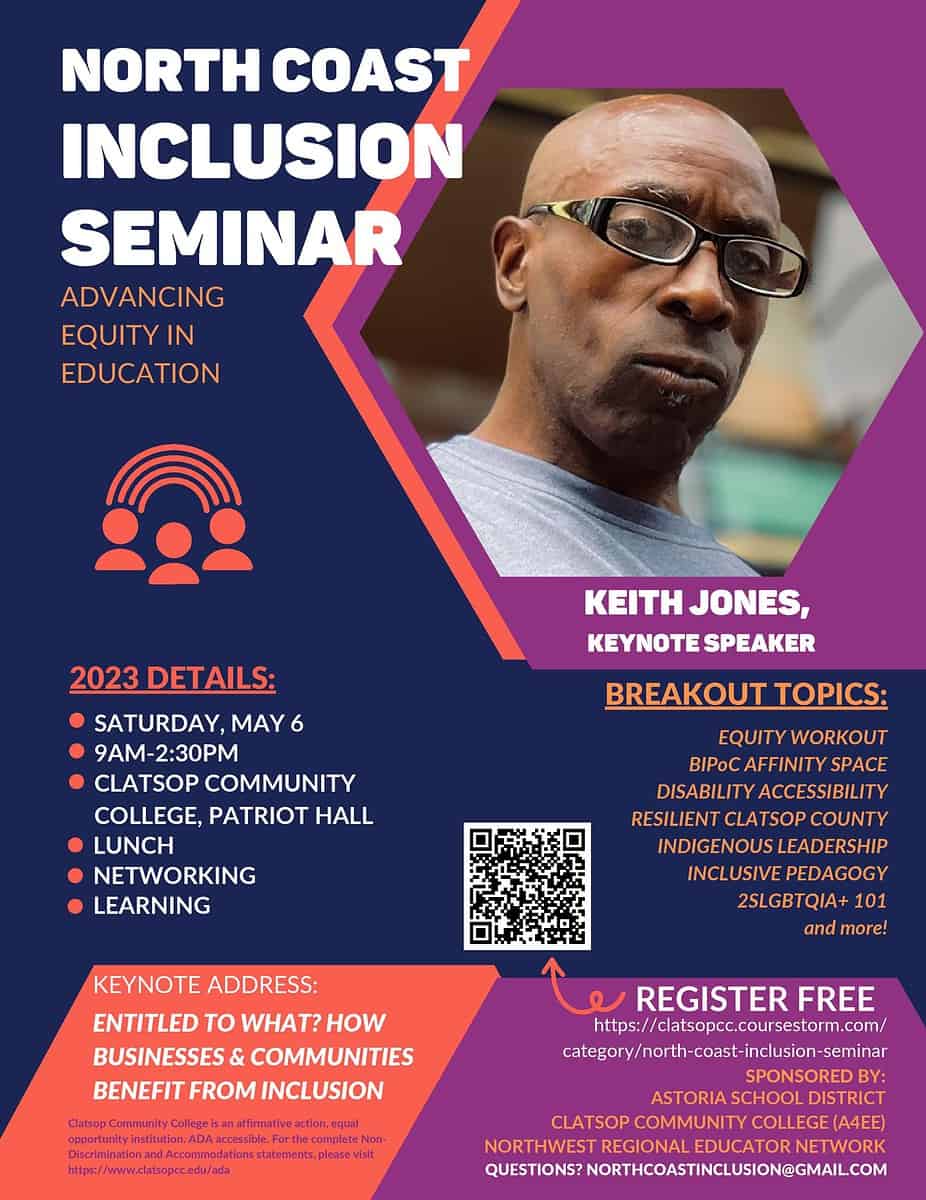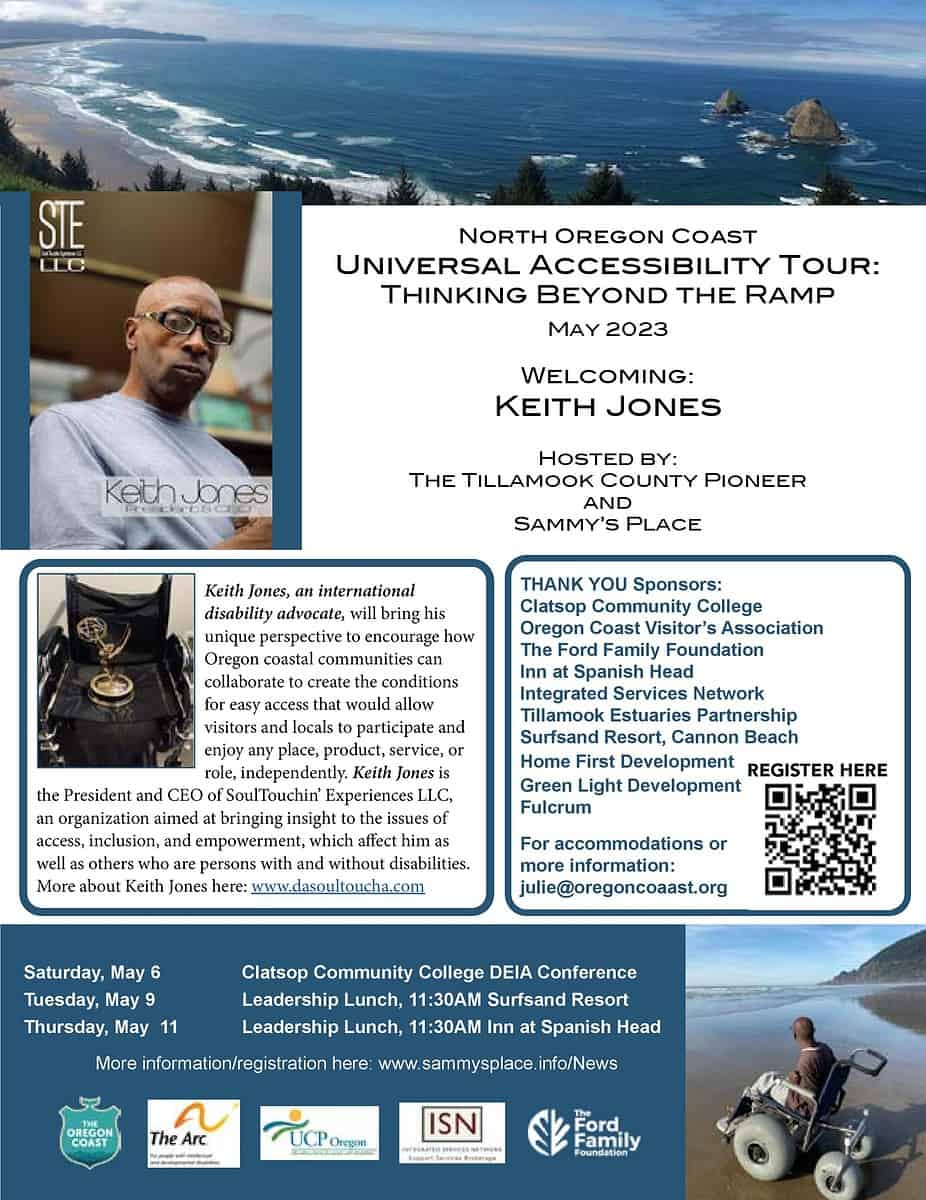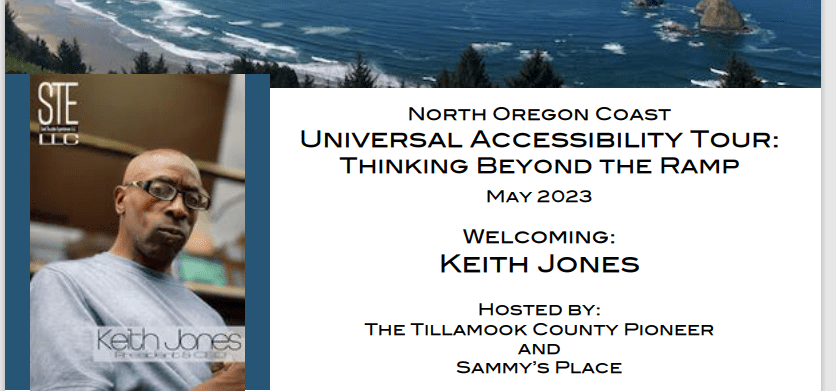EDITOR’S NOTE: The Tillamook County Pioneer and Sammy’s Place are hosting international disability justice activist Keith Jones May 6th through 11th on the North Oregon Coast Universal Accessibility Tour. Jones is the keynote speaker at Clatsop Community College’s North Coast Inclusion Seminar on Saturday, and county commissioners are hosting leadership luncheons with Keith in Cannon Beach on May 9th and Lincoln City on May 11th. See flyer information below for registration information. Universal Accessibility is more than just a ramp and ADA. Here is more information about how we can all benefit from Universal Access.
Do you ever notice how useful sidewalk curb cuts are? Perhaps you never think about them but consider the question for a moment…A child on a bicycle, parents pushing a stroller, and delivery workers pulling a cart all rely on sidewalk curb cuts to make their lives easier and safer. Originally designed for people in wheelchairs, sidewalk curb cuts are universally used and appreciated by everybody. This is an example of a concept called Universal Design.
Universal Design is defined as “the design of products and environments to be usable by all people, to the greatest extent possible, without the need for adaptation or specialized design,” by the North Carolina State University Center for Universal Design. Two key concepts in this definition are that products and environments are (1) usable by all people and (2) do not need adaptation. It aims to make products and environments truly universal without segregating or reducing the experience for anyone. This leads to a larger concept called Universal Access.
Universal Access means having the supports or accommodations needed to gain access that would allow any individual to participate and enjoy a place, product, service, or role independently. Universal Design contributes to advancing Universal Access. Many of us experience this in our everyday lives without even noticing it. Universal design and universal access are in place when we push our grocery cart through automatic doors without having to use our hands.
But, while many of us take this design and access for granted, we are all too aware of it when it is missing. Recall the last time you reached for a pair of scissors, only to find that they don’t work for you because you are left-handed. Or consider the last time you bought your kids a toy that said “some assembly required” only to find that the assembly instructions were so convoluted and complicated that you could never figure out how to put the thing together. These are but two small examples of products that are designed without the principles of universal design. These are two products that are not universally accessible.
These examples might seem like mild nuisances but consider if you are someone who has a physical, intellectual, or developmental disability. What seems like a small nuisance to one person might present a sizeable barrier to someone else. Just like right-handed scissors might make the simple task of cutting paper nearly impossible for someone who is left-handed, trying to access a building that has no automatic door might make an entire building – and all the services inside the building – inaccessible to someone who recently had a stroke or has cerebral palsy. Can you think of any buildings or services that you rely on that might be inaccessible to you should you experience such a condition?
Universal Design is for everyone and Universal Access benefits everyone. Products and environments created with the principles of Universal Design can benefit anyone now, and their benefits will only grow as we all age into disability. According to the ADA National Network, “More than 30 percent of Americans over age 65 have some kind of disability, and over 50 percent of those over age 75. These may range from difficulties seeing and hearing to walking and thinking.” For almost all of us, we will either develop a disability ourselves or have close friends and family who develop a disability. This means that we all stand to benefit from creating the conditions for easy access that allow any individual to participate and enjoy a place, product or service independently and from changing cultural norms, attitudes and perceptions of disability in our community.
Sammy’s Place is our local 501c3 nonprofit organization that is actively working to advance universal accessibility in the places we all love to live, work, and play along Oregon’s North Coast. We exist to create new opportunities within the coastal region so everyone can fully participate and thrive in their community of choice. We recognize that while disability is a natural part of life, the Oregon Coast – our home – is not yet universally accessible and welcoming to people with disabilities. But we envision a welcoming coastal region where everybody has what they need to fully participate and thrive in their community of choice, and we celebrate the unique strengths of every individual who visits or calls this place home.
To learn more about our work promoting Universal Design and Universal Access on the Oregon Coast, contact Sammy’s Place Executive Director, Julie Chick, at julie@oregoncoaast.org. You can also learn more about Universal Design and the concepts discussed in this article by visiting the website for the North Carolina State University Center for Universal Design and the University of Washington DO-IT Center.
North Carolina State University Center for Universal Design
https://design.ncsu.edu/research/center-for-universal-design/
University of Washington DO-IT Center.
https://www.washington.edu/doit/what-universal-design-0




